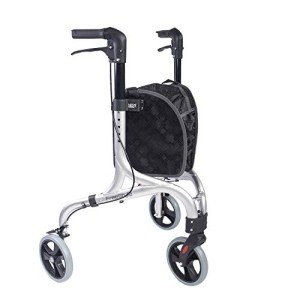EasterlingRex
EasterlingRex发表的博客
Understanding Rollators for Walking: A Comprehensive Guide
Rollators are an important mobility aid that boosts the liberty and self-reliance of those with restricted walking capabilities. They are designed not only to offer stability and support but also to motivate mobility and engagement in daily activities for people of any ages. This article digs deep into the world of rollators, supplying insights into their features, benefits, types, maintenance, and essential considerations when choosing the most appropriate design.
What is a Rollator?
A rollator is a mobile walking aid equipped with four wheels, handgrips, a seat, and typically includes additional features such as storage baskets and brakes. Unlike traditional walkers, which need the user to raise them off the ground, rollators can be pressed along as the user strolls, making them particularly beneficial for individuals with restricted strength or balance.

Secret Features of Rollators
Rollators consist of a number of functions that improve their functionality:
- Wheels: Most rollators feature swivel or fixed wheels for better maneuverability inside and outdoors.
- Brakes: Hand brakes permit users to manage their speed and stop safely.
- Seat: Many rollators provide an integrated seat for users to rest when needed.
- Lightweight Frame: Constructed from lightweight materials, rollators are easy to lift and carry.
- Adjustable Height: Most rollators permit height modifications to accommodate the user's stature.
Benefits of Using a Rollator
Utilizing a rollator uses many benefits, particularly for seniors and people with mobility difficulties. These may consist of:
- Improved Stability: Rollators offer a steady base that helps prevent falls.
- Increased Mobility: Users can move about more freely, whether inside your home or outdoors.
- Boosted Independence: With a rollator, users can carry out day-to-day tasks without needing assistance.
- Hassle-free Seating: The accessibility of a seat permits users to rest whenever they feel fatigued.
Types of Rollators
When thinking about which rollator to pick, it's important to acknowledge the numerous types offered. The main classifications include:
- Standard Rollators: Typically have four wheels and a seat, suitable for the majority of indoor and outdoor environments.
- Heavy-Duty Rollators: Designed for bigger individuals, these rollators have strengthened frames and greater weight capacities.
- Three-Wheel Rollators: These supply a more lightweight and compact option, making them ideal for narrower areas.
- Foldable Rollators: Convenient for transportation, these models can be quickly collapsed and stored when not in use.
| Kind of Rollator | Description | Best For |
|---|---|---|
| Standard Rollator For Walking | Four wheels, seat, lots of choices. | General use, indoor and outdoor. |
| Durable Rollator | Reinforced for greater weight capacity. | Larger people needing extra assistance. |
| Three-Wheel Rollator | Compact and lightweight, simple to maneuver. | Limited area and indoor use. |
| Foldable Rollator | Collapsible for simple transportation. | Regular tourists or caretakers. |
How to Choose the Right Rollator
Picking the right rollator includes considering several aspects to fulfill the person's particular needs:
- Weight Capacity: Ensure the rollator can support the user's weight.
- Height Adjustability: Look for models that can be gotten used to the user's height for optimum convenience.
- Features Needed: Consider whether extra features like baskets, trays, or hand brakes are necessary.
- Intended Use: Determine if the rollator will be mostly used inside your home, outdoors, or both.
Upkeep Tips for Rollators
To extend the life expectancy and performance of a rollator, regular upkeep is essential. Here are some useful ideas:
- Check Brakes: Regularly test brakes to guarantee they engage properly.
- Check Wheels: Look for signs of wear and tear; wheels need to roll smoothly.
- Clean Regularly: Wipe down the frame and parts to prevent dirt buildup.
- Tighten up Bolts: Periodically check and tighten any loose bolts or screws.
Frequently Asked Questions (FAQs)
1. Can rollators be utilized on unequal surfaces?
Yes, numerous rollators are created with larger wheels or specialized treads to deal with uneven surface areas. However, users must work out care and guarantee they feel steady when browsing such surfaces.
2. How do I determine the proper height for a rollator?
When standing straight, the deals with of the rollator must align with the user's wrist when their arms are unwinded at their sides. This position ensures comfortable use.
3. Do I need a prescription to purchase a rollator?
No, rollators can be acquired without a prescription. Nevertheless, seeking advice from a healthcare expert can be helpful to recognize the best alternative based upon individual needs.

4. Are rollators covered by insurance coverage?
Coverage for rollators can differ based upon the kind of insurance coverage strategy. Many Medicare strategies supply coverage for some types of walkers, consisting of rollators. It's suggested to talk to the insurance coverage supplier directly.
Rollators for walking substantially enhance the lives of numerous individuals facing mobility obstacles. Providing stability, self-reliance, and ease of motion, they function as important tools for preserving an active way of life. Comprehending the various types, features, and how to keep them in good condition can empower users in making notified decisions. As mobility requirements differ significantly from individual to individual, it is necessary to pick a rollator that best satisfies specific requirements and enhances lifestyle.
